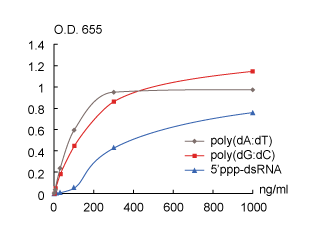Poly(dG:dC) naked
-
Cat.code:
tlrl-pgcn
- Documents
ABOUT
Synthetic double-stranded DNA
Poly(dG:dC) is a poly(deoxyguanylic-deoxycytidylic) acid sodium salt. It is a repetitive synthetic double-stranded DNA sequence of poly(dG-dC)•poly(dC-dG).
Intracellular poly(dG:dC) is detected by several cytosolic DNA sensors (CDS), such as cGAS [1], DAI [2], DDX41 [2, 3], IFI16 [2, 3] and LRRFIP1 [2, 4], triggering the production of type I interferons (IFNs). This induction of IFN appears to be mediated by the endoplasmic reticulum protein STING [1, 4, 5].
Moreover, Poly(dG:dC) activates the cytosolic DNA sensor AIM2 (absent in melanoma 2) to trigger inflammasome formation, leading to the secretion of the pro-inflammatory cytokines IL-1β and IL-18 [6].
To achieve stimulation of cytosolic DNA sensors, Poly(dG:dC) must be delivered into the cytoplasm, for example by using a transfection agent, such as LyoVec™.
Key features of Poly(dG:dC):
- Poly(dG:dC) is a cytosolic DNA sensor (CDS) agonist
- Each lot is functionally tested
- For your convenience, pre-complexed Poly(dG:dC)/ LyoVec™ is also available
References:
1. Unterholzner L., 2013. The interferon response to intracellular DNA: why so many receptors? Immunobiology. 218(11):1312-21.
2. Takaoka A. et al., 2007. DAI (DLM-1/ZBP1) is a cytosolic DNA sensor and an activator of innate immune response. Nature. 448(7152):501-5.
3. Zhang Z. et al., 2011. The helicase DDX41 senses intracellular DNA mediated by the adaptor STING in dendritic cells. Nat Immunol. 12(10):959-65.
4. Yang P. et al., 2010. The cytosolic nucleic acid sensor LRRFIP1 mediates the production of type I interferon via a beta-catenin-dependent pathway. Nat Immunol. 11(6):487-94.
5. Wu J. et al., 2013. Cyclic GMP-AMP is an endogenous second messenger in innate immune signaling by cytosolic DNA. Science. 339(6121):826-30.
6. Jones JW. et al., 2010. Absent in melanoma 2 is required for innate immune recognition of Francisella. PNAS, 107(21):9771-6.
All products are for research use only, and not for human or veterinary use.
SPECIFICATIONS
Specifications
CDS
2 mg/ml in physiological water
Naked
Negative (tested using EndotoxDetect™ assay)
Cellular assays
Production of type I interferons (IFNs), Inflammasome induction (IL-1β and IL-18 pro-inflammatory cytokine secretion)
Each lot is functionally tested and validated using THP1-Blue™ ISG Cells.
CONTENTS
Contents
-
Product:Poly(dG:dC) naked
-
Cat code:tlrl-pgcn
-
Quantity:200 µg
1.5 ml sterile endotoxin-free physiological water (150 mM NaCl)
Shipping & Storage
- Shipping method: Room temperature
- -20°C
- Avoid repeated freeze-thaw cycles
Storage:
Caution:
Details

Responses of B16-Blue™ IFNα/β cells to dsDNA and dsRNA:
B16-Blue™ IFNα/β cells were stimulated with increasing concentrations of poly(dA:dT), poly(dG:dC) or 5’ppp-dsRNA complexed extemporaneously with the transfection reagent LyoVec™.
After 24h incubation, induction of type I IFNs was assessed by determining the levels of SEAP using QUANTI-Blue™, a SEAP detection medium.
DOCUMENTS
Documents
Technical Data Sheet
Safety Data Sheet
Certificate of analysis
Need a CoA ?



